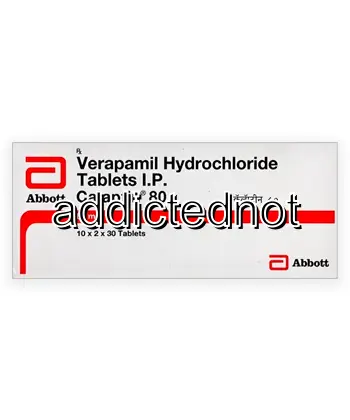| Package | Dosage | Price | Price per Dose | |
|---|---|---|---|---|
| Dosage: 40mg | ||||
| 270 pill | 40mg | $91.30 | $0.34 | |
| 120 pill | 40mg | $50.71 | $0.42 | |
| 90 pill | 40mg | $42.26 | $0.47 | |
| 60 pill | 40mg | $33.80 | $0.56 | |
| Dosage: 120mg | ||||
| 270 pill | 120mg | $206.29 | $0.76 | |
| 120 pill | 120mg | $103.13 | $0.86 | |
| 90 pill | 120mg | $84.53 | $0.95 | |
| 60 pill | 120mg | $67.62 | $1.13 | |
| 30 pill | 120mg | $43.95 | $1.47 | |

Verapamil Hydrochloride Description
Introduction to Verapamil Hydrochloride
Verapamil Hydrochloride is a widely used medication primarily prescribed for managing various cardiovascular conditions. It belongs to the class of drugs known as calcium channel blockers. By affecting the calcium influx in the cells of the heart and blood vessels, it helps regulate heart rate and relaxes blood vessels. This dual action makes it effective for treating conditions such as hypertension, angina pectoris, and certain types of cardiac arrhythmias.
Mechanism of Action
Verapamil works by inhibiting the flow of calcium ions through voltage-gated calcium channels in the muscle cells of the heart and blood vessels. This decrease in calcium entry results in reduced contraction strength of the heart muscle and dilation of the arteries. As a consequence, it lowers blood pressure and reduces the workload on the heart. The medication also slows down the electrical conduction in the heart, thus helping to control abnormal heart rhythms.
Benefits and Uses
Patients taking Verapamil Hydrochloride often experience a significant reduction in symptoms related to high blood pressure and angina. It is particularly beneficial in relieving chest pain caused by ischemia. The medication helps prevent angina attacks by improving blood supply to the heart muscle. For certain arrhythmias, such as supraventricular tachycardia, Verapamil helps restore normal heart rhythm and prevent episodes from occurring.
Possible Side Effects
While many patients tolerate Verapamil Hydrochloride well, some may experience side effects. Common issues include dizziness, flushing, headache, and fatigue. Some individuals might notice swelling in the ankles or feet due to its vasodilatory effects. Gastrointestinal disturbances such as nausea or constipation are also reported. Rarely, more severe reactions like abnormal heart rhythms or allergic responses can occur, which require immediate medical attention.
Precautions and Interactions
It is important for users to inform their healthcare provider about other medications they are taking to avoid potential interactions. Verapamil may interact with beta-blockers, other antihypertensives, and certain antibiotics, increasing the risk of side effects. Patients with existing heart conditions, such as heart failure or conduction system diseases, should use the medication cautiously. Pregnant or breastfeeding women should consult their doctor before starting treatment, as safety data is limited for these groups.
Usage Guidelines
Verapamil Hydrochloride is usually prescribed in specific dosages tailored to the patient’s condition and response. It can be administered orally, either as a tablet or extended-release form. The medication should be taken consistently, preferably at the same times daily, with or without food, depending on the healthcare provider’s instructions. Regular monitoring of blood pressure and heart rhythm is essential during treatment to assess effectiveness and detect any adverse effects early.
Conclusion
Overall, Verapamil Hydrochloride is a versatile and effective medication for controlling various cardiovascular conditions. When used appropriately under medical supervision, it offers significant benefits in reducing symptoms and improving quality of life for patients with hypertension, angina, or arrhythmias. Like all medications, it requires careful consideration of potential side effects and interactions, but with proper management, it can be a valuable part of cardiovascular therapy.